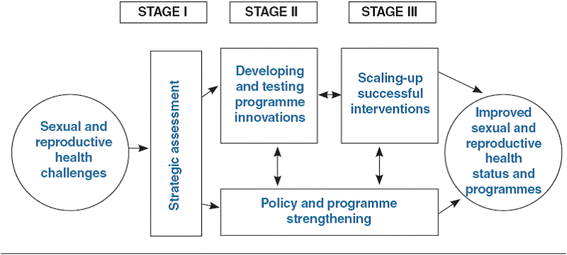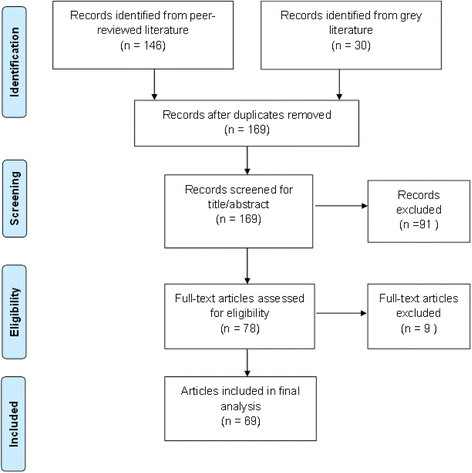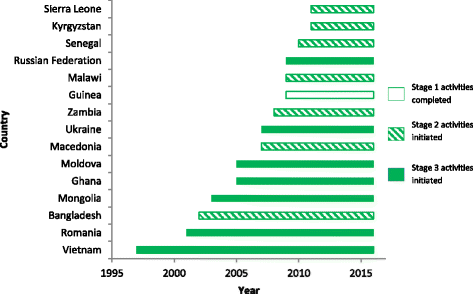Evaluating implementation of the World Health Organization's Strategic Approach to strengthening sexual and reproductive health policies and programs to address unintended pregnancy and unsafe abortion
- PMID: 29157274
- PMCID: PMC5697396
- DOI: 10.1186/s12978-017-0405-3
Evaluating implementation of the World Health Organization's Strategic Approach to strengthening sexual and reproductive health policies and programs to address unintended pregnancy and unsafe abortion
Abstract
Background: We conducted a process evaluation to assess how the World Health Organization's (WHO) Strategic Approach to strengthening sexual and reproductive health policies and programs ("the SA") was used in 15 countries that requested WHO's technical support in addressing unintended pregnancy and unsafe abortion. The SA is a three-stage planning, policy, and program implementation process. We used the social ecological model (SEM) to analyze the contextual factors that influenced SA implementation.
Methods: We used a two-phased sequential approach to data collection and analysis. In Phase A, we conducted a document and literature review and synthesized data thematically. In Phase B, we conducted interviews with stakeholders who used the SA in the countries of interest. We used a qualitative method triangulation technique to analyze and combine data from both phases to understand how the SA was implemented in each country.
Results: Data from 145 documents and 19 interviews described the SA process and activities in each country. All 15 countries completed Stage 1 activities. The activities of Stage 1 determined activities in subsequent stages and varied across countries. Following Stage 1, some countries focused on reforming policies to improve access to sexual and reproductive health (SRH) services whereas others focused on improving provider-level capacity to enhance SRH service quality and improving community-level SRH education. We identified factors across SEM levels that affected SA implementation, including individual- and community-level perceptions of using the SA and the recommendations that emerged from its use, organizational capacity to conduct SA activities, and how well these activities aligned with the existing political climate. Stakeholders perceived SA implementation to be country-driven and systematic in bringing attention to important SRH issues in their countries.
Conclusion: We identified key success factors for influencing the individual, organization, and system change required for implementing the SA. These include sustaining stakeholder engagement for all SA stages, monitoring and reporting on activities, and leveraging activities and outputs from each SA stage to obtain technical and financial support for subsequent stages. Results may be used to optimize ongoing implementation efforts to improve access to and the quality of SRH services.
Keywords: Contextual factors; Implementation; Process evaluation; Sexual reproductive health; Social ecological model; Strategic Approach; Unintended pregnancy; Unsafe abortion.
Conflict of interest statement
Ethics approval and consent to participate
Ethics approval was obtained from the University of Toronto Health Sciences Research Ethics Board (REB #31181), and verbal informed consent was obtained from all participants. Data were de-identified prior to analysis.
Consent for publication
Not applicable.
Competing interests
The authors declare that they have no competing interests.
Publisher’s Note
Springer Nature remains neutral with regard to jurisdictional claims in published maps and institutional affiliations.
Figures
Similar articles
-
Developing integrated community-based HIV prevention, harm reduction, and sexual and reproductive health services for women who inject drugs.Reprod Health. 2019 May 29;16(Suppl 1):59. doi: 10.1186/s12978-019-0711-z. Reprod Health. 2019. PMID: 31138238 Free PMC article.
-
Sexual lives and reproductive health outcomes among persons with disabilities: a mixed-methods study in two districts of Ghana.Reprod Health. 2024 May 23;21(1):69. doi: 10.1186/s12978-024-01810-4. Reprod Health. 2024. PMID: 38783342 Free PMC article.
-
Priority-setting to integrate sexual and reproductive health into universal health coverage: the case of Malaysia.Sex Reprod Health Matters. 2020 Dec;28(2):1842153. doi: 10.1080/26410397.2020.1842153. Sex Reprod Health Matters. 2020. PMID: 33236973 Free PMC article.
-
A scoping review of qualitative studies on sexual and reproductive health and rights in Uganda: Exploring factors at multiple levels.Womens Health (Lond). 2024 Jan-Dec;20:17455057241285193. doi: 10.1177/17455057241285193. Womens Health (Lond). 2024. PMID: 39345026 Free PMC article.
-
An overview of the sexual and reproductive health status and service delivery among Syrian refugees in Jordan, nine years since the crisis: a systematic literature review.Reprod Health. 2020 Oct 28;17(1):166. doi: 10.1186/s12978-020-01005-7. Reprod Health. 2020. PMID: 33115474 Free PMC article.
Cited by
-
Opportunities for linking research to policy: lessons learned from implementation research in sexual and reproductive health within the ANSER network.Health Res Policy Syst. 2018 Dec 17;16(1):123. doi: 10.1186/s12961-018-0397-7. Health Res Policy Syst. 2018. PMID: 30558612 Free PMC article.
-
A process evaluation of the Communication for Healthy Communities adolescent health program in Uganda.Health Educ Res. 2020 Feb 1;35(1):15-31. doi: 10.1093/her/cyz032. Health Educ Res. 2020. PMID: 31763679 Free PMC article.
-
Preventing death following unsafe abortion: a case series from urban Uganda.AJOG Glob Rep. 2022 Feb;2(1):100039. doi: 10.1016/j.xagr.2021.100039. AJOG Glob Rep. 2022. PMID: 35252906 Free PMC article.
-
Main actors in the new population policy with a growing trend in Iran: a stakeholder analysis.J Health Popul Nutr. 2022 Dec 12;41(1):57. doi: 10.1186/s41043-022-00338-2. J Health Popul Nutr. 2022. PMID: 36510303 Free PMC article.
-
Sexual needs of people with schizophrenia: a descriptive phenomenological study.BMC Psychiatry. 2023 Mar 9;23(1):147. doi: 10.1186/s12888-023-04640-z. BMC Psychiatry. 2023. PMID: 36894926 Free PMC article.
References
-
- WHO . Unsafe abortion: global and regional estimates of the incidence of unsafe abortion and associated mortality in 2008. Geneva: WHO; 2011.
-
- WHO . World Health Organization information sheet in unsafe abortion incidence and mortality global and regional levels in 2008 and trends during 1990–2008. Geneva: WHO; 2012.
-
- Kassebaum NJ, Bertozzi-Villa A, Coggeshall MS, Shackelford KA, Steiner C, Heuton KR, et al. Global, regional, and national levels and causes of maternal mortality during 1990-2013: a systematic analysis for the global burden of disease study 2013. Lancet. 2014;384(9947):980–1004. doi: 10.1016/S0140-6736(14)60696-6. - DOI - PMC - PubMed
Publication types
MeSH terms
Grants and funding
LinkOut - more resources
Full Text Sources
Other Literature Sources
Medical





